 A turnstile is a type of gate that makes it possible to control entry and exit into and out of a specific location. A traditional turnstile consists of a set of 3 arms that extend horizontally from a post to act as a barrier to entry. These arms rotate to allow entry or lock to restrict access. A turnstile can provide security, organize crowds, prevent losses from theft, and control access.
A turnstile is a type of gate that makes it possible to control entry and exit into and out of a specific location. A traditional turnstile consists of a set of 3 arms that extend horizontally from a post to act as a barrier to entry. These arms rotate to allow entry or lock to restrict access. A turnstile can provide security, organize crowds, prevent losses from theft, and control access.
Turnstiles have a wide range of applications and are used in a multitude of venues. Places that commonly employ turnstiles include amusement parks, public transit systems, airports, and sporting venues. Most modern turnstiles are mechanical, allowing operators to control how turnstile arms act. A turnstile can be built to spin in one direction, in the opposite direction, or in both, depending on end-user needs. Most turnstiles are electronically operated – they contain an electronic locking mechanism that can remotely lock or unlock a turnstile. Many of today’s high technology turnstiles operate with optical sensors that detect when objects pass through their lanes.
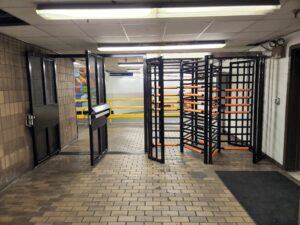 Turnstiles come in various sizes and configurations, ranging from waist high to full height. A traditional three arm (tripod) waist high turnstile is a good choice for tight spaces or when a portable turnstile is needed. On the other end of the spectrum, a full height turnstile is a great option for high-security applications because it provides floor-to-ceiling protection.
Turnstiles come in various sizes and configurations, ranging from waist high to full height. A traditional three arm (tripod) waist high turnstile is a good choice for tight spaces or when a portable turnstile is needed. On the other end of the spectrum, a full height turnstile is a great option for high-security applications because it provides floor-to-ceiling protection.
Because the Americans with Disabilities Act (ADA) passed in 1990 requires equal opportunities for individuals with physical disabilities, some turnstiles and gates are designed specifically to be used by those in wheelchairs or using a walker. These gates and turnstiles have wider lanes to accommodate disabled individuals. Hayward Turnstiles Optical Turnstiles can also be made ADA compliant lane widths based on end-user needs.
There are other methods used to control crowds and direct traffic besides turnstiles and ADA gates. For example, stanchions (rail and posts systems) can be employed as semi-permanent to permanent crowd controlling solutions. This type of barrier is commonly used to designate lanes inside an area like a bank lobby and are frequently used in airport terminals to organize the large crowds. Temporary stanchions consist of moveable posts with retractable belts and can be easily moved or reconfigured. For a more permanent solution, a metal post and rail system may be installed and bolted securely into the ground.
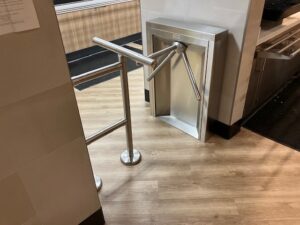 The access control industry is vast and full of many different products and systems. It is important to understand the different types of turnstiles and gates and where they work best.
The access control industry is vast and full of many different products and systems. It is important to understand the different types of turnstiles and gates and where they work best.

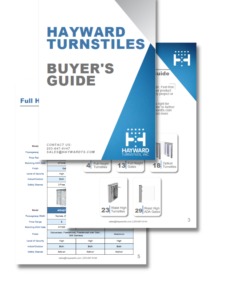
 A turnstile is a type of
A turnstile is a type of  Turnstiles come in various sizes and configurations, ranging from
Turnstiles come in various sizes and configurations, ranging from  The access control industry is vast and full of many different
The access control industry is vast and full of many different 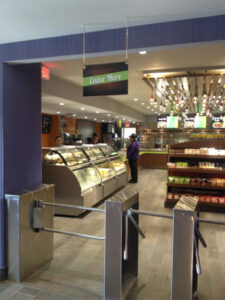
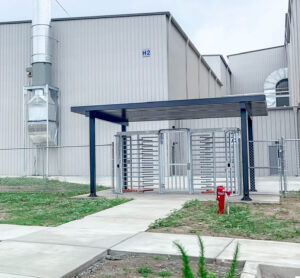 Full Height turnstiles are larger, tougher and offer greater
Full Height turnstiles are larger, tougher and offer greater  Barrier Free Optical Turnstiles do not have a physical barrier to resist entry. The lane is open – allowing all traffic to pass freely without encountering obstacles. Barrier-free optical turnstiles operate solely through optical detection and trigger alarms when unauthorized individuals pass through their lanes. Often, this type of turnstile will be used to count patrons passing through the lanes for monitoring attendance. Since barrier-free optical turnstiles are passive security devices without physical restraints, it is recommended to employ an attendant nearby to address alarm conditions appropriately and confront possible intruders. Barrier-free optical turnstiles are often used in
Barrier Free Optical Turnstiles do not have a physical barrier to resist entry. The lane is open – allowing all traffic to pass freely without encountering obstacles. Barrier-free optical turnstiles operate solely through optical detection and trigger alarms when unauthorized individuals pass through their lanes. Often, this type of turnstile will be used to count patrons passing through the lanes for monitoring attendance. Since barrier-free optical turnstiles are passive security devices without physical restraints, it is recommended to employ an attendant nearby to address alarm conditions appropriately and confront possible intruders. Barrier-free optical turnstiles are often used in 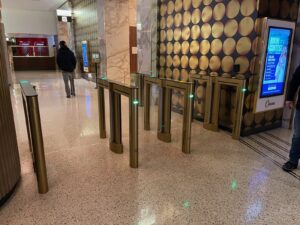 Optical Turnstiles with Barriers present a physical obstacle to entry. Motorized barriers are used in conjunction with optical sensors to present a physical barrier until a valid credential is presented. Like with Barrier Free Optical Turnstiles, system users present access credentials to a reader installed in the turnstile. If the credential is valid, the barriers open. Otherwise, barriers remain closed. If a user tries to force entry or present a bad credential, lights and alarms may be triggered to alert the surrounding area of the intrusion. Once a user has passed through the lane, the barriers automatically close. These turnstiles are often used in
Optical Turnstiles with Barriers present a physical obstacle to entry. Motorized barriers are used in conjunction with optical sensors to present a physical barrier until a valid credential is presented. Like with Barrier Free Optical Turnstiles, system users present access credentials to a reader installed in the turnstile. If the credential is valid, the barriers open. Otherwise, barriers remain closed. If a user tries to force entry or present a bad credential, lights and alarms may be triggered to alert the surrounding area of the intrusion. Once a user has passed through the lane, the barriers automatically close. These turnstiles are often used in  The Americans with Disabilities Act (
The Americans with Disabilities Act ( Portable Turnstiles are
Portable Turnstiles are 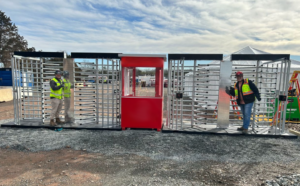 Portable full height turnstiles are used most commonly at
Portable full height turnstiles are used most commonly at  Turnstiles come in a vast array of sizes, shapes, finishes, and configurations. It is important to pick the correct turnstile for your needs.
Turnstiles come in a vast array of sizes, shapes, finishes, and configurations. It is important to pick the correct turnstile for your needs.
 When a turnstile’s locking and unlocking functions are controlled electrically, a decision must be made about how that turnstile should act in the event of a power outage or emergency. Turnstile mechanisms can be configured to either lock or unlock automatically when power fails. A Fail Safe turnstile automatically unlocks when it loses power, allowing for free entry of life safety personnel and free exit of visitors. Fail Safe turnstiles can be integrated with a building’s alarm system. A Fail Secure turnstile automatically locks when it loses power, keeping all persons confined to respective areas.
When a turnstile’s locking and unlocking functions are controlled electrically, a decision must be made about how that turnstile should act in the event of a power outage or emergency. Turnstile mechanisms can be configured to either lock or unlock automatically when power fails. A Fail Safe turnstile automatically unlocks when it loses power, allowing for free entry of life safety personnel and free exit of visitors. Fail Safe turnstiles can be integrated with a building’s alarm system. A Fail Secure turnstile automatically locks when it loses power, keeping all persons confined to respective areas.